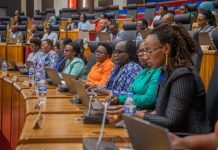Africa-Press – Rwanda. Last week, news of the RTS,S/AS01 (RTS,S), a ground-breaking Malaria vaccine being given a go-ahead by the World Health Organisation (WHO) made headlines around the world.
The WHO recommended its widespread use among children under the age of 5 in sub-Saharan Africa and in other regions with moderate to high P. falciparum malaria transmission
P. falciparum is the deadliest malaria parasite globally, and the most prevalent in Africa. WHO’s recommendation of the vaccine was based on results from the ongoing pilot programme in Ghana, Kenya and Malawi that has reached more than 800 000 children since 2019.
The vaccine is only effective in preventing only a third (about 30 percent) of malaria cases, but medics are optimistic about the impact it can create, despite such modest efficacy.
“A number of the vaccines that we have used for long didn’t have a high efficacy but had a lot of public health impact and that is what is going to happen with this vaccine,” Bernard Ogutu, a Kenyan doctor who worked on the vaccine’s research project said, adding that even with a modest efficacy of 30 percent, its impact in terms of averting clinical malaria cases runs into millions.
Commenting about the vaccine, Dr. Aimable Mbituyumuremyi, the Head of the National Malaria Control Program, other Parasitic Diseases and Neglected Tropical Diseases Division within the Rwanda Biomedical Center (RBC) told The New Times that considering its efficacy, it should be used hand-in-hand with the other preventive measures that are already in place.
“When you look at the efficacy of the vaccine, you can’t say it should be used alone. It does not come in to replace the measures in place, but rather, should be used hand in hand with them to give more results,” he said.
Rwanda employs a number of measures to fight malaria including the use of mosquito nets, indoor residual spraying, early treatment for the infected, and so on.
WHO Director-General Tedros Ghebreyesus also hinted on the use of the vaccine along with the rest of the existing preventive tools. “Using this vaccine in addition to existing tools to prevent malaria could save tens of thousands of young lives each year,” he said.
According to Mbituyumuremyi, the fact that the vaccine is for children under the age of 5 is good is something good, since children are much affected by malaria in Rwanda.
Citing statistics of last year (2020/2021), he said about 40 percent of the people that were killed by malaria in Rwanda were children under the age of five. In general, the malaria epidemic has been waning recently in the country.
In 2020/2021, the number of people who suffered from the disease were about 1000,400 in the country, a significant decrease from the 2.5 million who suffered from it in 2019/2020.
Those who suffered from severe malaria in 2020/2021 were 2,500, while in 2019/2020 they reached up to 4,300. 96 people succumbed to malaria in 2020/2021 and 37 of these were children under the age of 5. The number was even higher in 2019/2020, where 167 people were killed by the disease.
“I think this is a big picture that shows that the numbers are going down, but the battle is still there, and so, the measures should be maintained,” Mbituyumuremyi said.
Globally, Malaria kills about half a million people each year, nearly all of them in sub-Saharan Africa — including 260,000 children under 5. The World Health Organization’s endorsement of the vaccine can be considered as the first step in a process that should lead to wide distribution in poor countries.
The next steps for the WHO-recommended malaria vaccine will include funding decisions from the global health community for broader rollout, and country decision-making on whether to adopt the vaccine as part of their national malaria control strategies.
Rolling out the vaccine The Vaccine Alliance (GAVI), a public–private global health partnership with the goal of increasing access to immunization in poor countries will deliberate in early December over how much to invest in RTS,S, according to a statement from the WHO.
In a statement, GlaxoSmithKline, the manufacturer of the vaccine committed to supplying up to 15 million doses of RTS,S each year if funding and recommendations for the vaccine’s wider use fell into place.
The company is also working to transfer production of the vaccine to the Indian company Bharat Biotech. GlaxoSmithKline also committed to selling the vaccines at no more than 5 percent higher than the cost of production.






